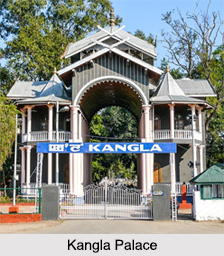 Originally situated on both the eastern and western sides of the banks of the Imphal River, the Kangla Palace is currently only on the western bank of the river. It is an old palace in the city of Imphal and was once a part of the ancient capital of the Kingdom of Manipur till the year 1891 AD.
Originally situated on both the eastern and western sides of the banks of the Imphal River, the Kangla Palace is currently only on the western bank of the river. It is an old palace in the city of Imphal and was once a part of the ancient capital of the Kingdom of Manipur till the year 1891 AD.
History of Kangla Palace
The Kangla Palace is one of the most important historical and archaeological sites in the Indian state of Manipur. It is said that the Kingdom of Manipur developed at Kangla. And being a political and religious centre, Kangla grew into a formidable fortress city over the centuries. It is from this capital that the Mangang clan gradually wielded enough political and military power to become the most dominant clan in Manipur.
After years of peaceful rule, on March, 1891, the British forces attacked the palace, which was then under the administration of Senapati Tikendrajit. The Manipuris fought back and the British were put on the defensive. The ensuing chaos resulted in several causalities and among them were five British officers, who were lynched by a mob. This resulted in the Anglo Manipuri War of 1891.
The British forces defeated the Manipuri army and publicly executed Senapati Tikendrajit along with the Thangal General among others. Thus the Kangla Palace came under British administration, which they declared as a cantonment area of the British Reserve. The palace remained under their control until the Indian Independence.
Archaeological History of Kangla Palace
Over the centuries, the Kangla Palace was developed by the successive reigning kings of the state. As per historical records, it states that in 1632, King Khagemba, the conqueror of the Chinese, constructed a brick wall at the western gate of Kangla Palace. It is believed that the art of brick making was adapted from the Chinese prisoners, who were captured during the Chinese invasion of the eastern frontier of Manipur.
When the king"s son Khunjaoba ascended the throne, he carried out the fortification and beautification work of the Kangla Palace. In the later period, the palace was further extended by King Gharib Nawaz and other successive kings of Manipur.
Features of Kangla Palace
Regarded to be as one of the holiest places among the people of Manipur, the Kangla Palace is a centre of pilgrimage in the North- East Indian states. It is said that there are about 360 important sacred places in Kangla, like the Nungjeng Eekon, a sacred pond that is believed to be the abode of Lord Pakhangba. Then there is the place of worship called Nunggoibi dedicated to the Goddess of War.
The "Huyein Lalu Chanba" ritual was performed here, whenever a king of Manipur emerged victorious in battle. Few of the other holy places within the premises of the palace are the coronation site or the Kangla Men Surung, the cremation site or the Manglen and the sites for Lord Wangbaren and Lord Koubru.
Some of the other ancient monuments found at Kangla are the ruins of the 20 ft high citadel, which was built in 1611 during the reign of King Khagemba. Then there is the ancestral coronation hall of the kings of Manipur called the Uttra, which is in ruins as well. In front of the Uttra were two huge Kangla Sha made out of bricks, which were unfortunately blown to smithereens by the British during the Anglo Manipur War. The Shree Govindajee Temple and the Temple of Brindaban Chandra were also once a part of Kangla.
The Kangla Palace is currently one of the popular tourist spots in the state that attracts visitors from all around.
Visiting Information on Kangla Palace
The newly commissioned Vangaichungpao railway station in the Imphal East District is the closest at a distance of about 195 km from the palace. The Imphal Airport is the nearest at a distance of 7 km from the Kangla Palace.



















